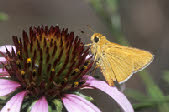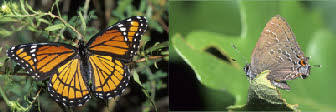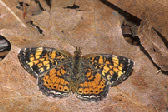The Butterflies of the World Foundation
A Non-





Satyrium calanus, Wichita Mountains National Wildlife Refuge, Comanche County, Oklahoma,
22 May 2007 Ref #:
I-
Banded Hairstreak
Satyrium calanus, Hübner, 1809
Subfamily Theclinae
Tribe Eumaeini
Taxonomy
The family Lycaenidae is a large and varied worldwide group that has 4,000 to 6,000
species depending on the ever-
All photographs, artwork, text and website design are the property of The Butterflies of the World Foundation (unless otherwise stated) and are protected under national and international copyright laws. Photographs, artwork or text on this website may not be reproduced in any way without prior written consent of The Butterflies of the World Foundation.

Blackjack Oak, Quercus marilandica, a common larval food source, Lexington Wildlife Management Area, Cleveland County, Oklahoma
Ref #: N-

Post Oak, Quercus stellata, a common larval food source, Lexington Wildlife Management
Area, Cleveland County, Oklahoma Ref
#: N-

Blackjack Oak, Quercus marilandica, a common larval food source, Lexington Wildlife
Management Area, Cleveland County, Oklahoma Ref #:
N-

Blackjack Oak, Quercus marilandica, a common larval food source, Lexington Wildlife
Management Area, Cleveland County, Oklahoma Ref #:
N-

Post Oak, Quercus stellata, a common larval food source, Lexington Wildlife Management
Area, Cleveland County, Oklahoma Ref
#: N-

Blackjack Oak, Quercus marilandica, a common larval food source, Lexington Wildlife
Management Area, Cleveland County, Oklahoma Ref
#: N-

Blackjack Oak, Quercus marilandica, a common larval food source, Lexington Wildlife
Management Area, Cleveland County, Oklahoma Ref #:
N-

Blackjack Oak, Quercus marilandica, a common larval food source, Lexington Wildlife
Management Area, Cleveland County, Oklahoma Ref #:
N-

Post Oak, Quercus stellata, a common larval food source, Lexington Wildlife Management
Area, Cleveland County, Oklahoma Ref
#: N-

Satyrium calanus, one half mile south of Lexington Wildlife Management Area, Cleveland
County, Oklahoma, 22 May 2006 Ref
#: I-

Satyrium calanus, Lexington Wildlife Management Area, Cleveland County, Oklahoma,
26 May 2006 Ref
#: I-

Satyrium calanus, Lexington Wildlife Management Area, Cleveland County, Oklahoma,
13 May 2007 Ref
#: I-

Satyrium calanus, one half mile south of Lexington Wildlife Management Area, Cleveland
County, Oklahoma, 22 May 2006 Ref
#: I-

Satyrium calanus, Lexington Wildlife Management Area, Cleveland County, Oklahoma,
2 June 2010 Ref
#: I-
General Information:
Satyrium calanus belongs to the subfamily Theclinae. It’s range includes most of the eastern half of the U.S. It is found in forested areas that have oaks.
Lifecycle:
The larval food plant for this species are oaks, Quercus sp., walnut Juglan sp., and hickory Carya sp. Males perch on trees to wait for females. Eggs are laid on twigs and larvae eat the catkins or leaves and hatch the following spring.

Satyrium calanus, Lexington Wildlife Management Area, Cleveland County, Oklahoma,
9 May 2012 Ref
#: I-

Satyrium calanus, Lexington Wildlife Management Area, Cleveland County, Oklahoma,
9 May 2012 Ref
#: I-

Satyrium calanus, Lexington Wildlife Management Area, Cleveland County, Oklahoma,
16 May 2012 Ref
#: I-

Satyrium calanus, Lexington Wildlife Management Area, Cleveland County, Oklahoma,
16 May 2012 Ref
#: I-

Satyrium calanus, Lexington Wildlife Management Area, Cleveland County, Oklahoma,
16 May 2012 Ref
#: I-

Satyrium calanus, Lexington Wildlife Management Area, Cleveland County, Oklahoma,
16 May 2012 Ref
#: I-

Satyrium calanus, Lexington Wildlife Management Area, Cleveland County, Oklahoma,
16 May 2012 Ref
#: I-